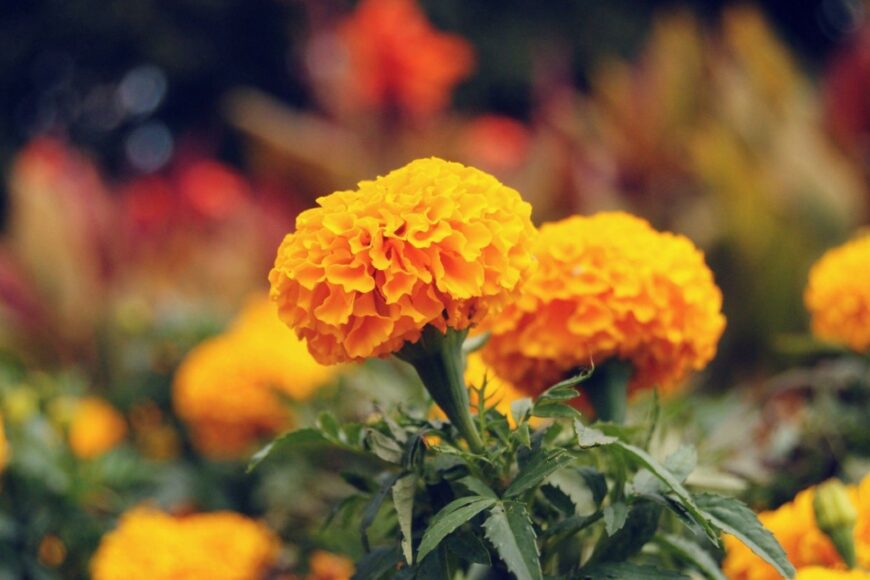
 Name: Marigold
Name: Marigold Family: Asteraceae
Family: Asteraceae Origins: Marigolds (Tagetes) are native to North and South America. They have been cultivated for centuries and are now popular in gardens worldwide.
Origins: Marigolds (Tagetes) are native to North and South America. They have been cultivated for centuries and are now popular in gardens worldwide. Humidity: Marigolds prefer moderate humidity levels. They can tolerate drier conditions, but consistent moisture is beneficial for optimal growth and flower production.
Humidity: Marigolds prefer moderate humidity levels. They can tolerate drier conditions, but consistent moisture is beneficial for optimal growth and flower production. Location: Marigolds thrive in full sunlight. Choose a location with at least 6 hours of direct sunlight daily for robust and vibrant plants.
Location: Marigolds thrive in full sunlight. Choose a location with at least 6 hours of direct sunlight daily for robust and vibrant plants. Soil: Well-draining soil is crucial for marigolds. They adapt to various soil types but prefer fertile, loamy soil. Adding organic matter like compost enhances soil structure and fertility.
Soil: Well-draining soil is crucial for marigolds. They adapt to various soil types but prefer fertile, loamy soil. Adding organic matter like compost enhances soil structure and fertility. Pests and diseases: Marigolds are relatively resistant to pests, but common issues include aphids, spider mites, and nematodes. Diseases like powdery mildew can occur in humid conditions. Companion planting with marigolds can help repel pests.
Pests and diseases: Marigolds are relatively resistant to pests, but common issues include aphids, spider mites, and nematodes. Diseases like powdery mildew can occur in humid conditions. Companion planting with marigolds can help repel pests. Care: Watering, Fertilizing, Pruning
Care: Watering, Fertilizing, Pruning Height of growth: Marigolds typically range from 6 inches to 3 feet in height, depending on the variety. French marigolds are generally shorter, while African marigolds can grow taller.
Height of growth: Marigolds typically range from 6 inches to 3 feet in height, depending on the variety. French marigolds are generally shorter, while African marigolds can grow taller. Planting in the soil: Selecting the Right Location
Planting in the soil: Selecting the Right LocationMarigolds are not just a feast for the eyes but also serve practical purposes in the garden. Known for their vibrant colors and pest-repelling qualities, these flowers are a popular choice among gardeners.
Content:
Choosing the Right Marigold Variety
There are various marigold varieties, including French and African marigolds. Consider factors such as size, color, and purpose (ornamental or pest control) when selecting the right one for your garden.
Planting Marigolds: A Step-by-Step Guide
a. Selecting the Right Location: Choose a spot with well-drained soil and ample sunlight.
b. Soil Preparation: Ensure the soil is rich in nutrients; add compost or well-rotted manure.
c. Planting Seeds or Transplants: Decide whether to start from seeds indoors or use transplants. Plant seeds or transplants according to package instructions.
Marigold Care Tips
a. Watering: Keep the soil consistently moist but not waterlogged. Water at the base to prevent fungal issues.
b. Fertilizing: Use a balanced fertilizer every 4-6 weeks during the growing season.
c. Pruning: Pinch off spent flowers to encourage continuous blooming.
Dealing with Pests and Diseases
Learn about common pests (like aphids and spider mites) and diseases affecting marigolds. Use organic remedies such as neem oil or companion planting with pest-repelling herbs.
Companion Planting with Marigolds
Marigolds act as natural pest deterrents. Consider planting them alongside vegetables and other susceptible plants to protect them from harmful insects.
Harvesting Marigold Flowers
Harvest marigold flowers when they are fully open. Pinch them off in the morning after the dew has dried for the best results. Use them for decorative purposes or in companion planting.
Benefits of Growing Marigolds in Your Garden
Marigolds not only add color to your garden but also contribute to its overall health. Their pest-repelling properties, ease of care, and versatility make them a valuable addition to any garden.
Feel free to adjust the content as needed for your specific audience and platform!

